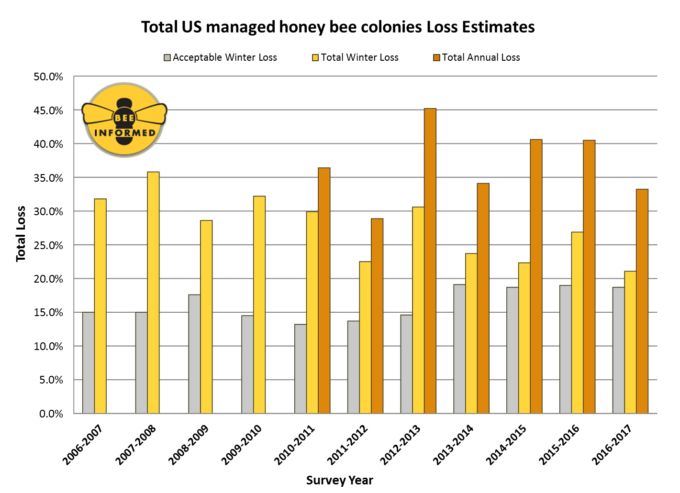Survey: Bee Loss Drops Last Season

Summary of total overwintering colony losses in the U.S. across eleven years of conducting the winter loss survey (yellow bars; October 1 to April 1) and across six years of conducting the summer (April 1 – October 1) and annual loss survey. Total annual loss values (orange bars) include total winter and total summer losses. The acceptable winter loss rate (grey bars) is the average percentage of acceptable yearly colony losses declared by the survey participants in each year of the survey. (Graphic: Bee Informed Partnership)
The Bee Informed Partnership, in collaboration with the Apiary Inspectors of America (AIA), conducted the 11th annual national survey of honeybee colony losses.
For the 2016-2017 winter season, 4,963 beekeepers in the U.S. provided validated survey responses. Collectively, these beekeepers managed 363,987 colonies in October 2016, representing about 13% of the country’s estimated 2.78 million managed honey producing colonies. An estimated 21.1% of colonies managed in the U.S. were lost over the 2016-2017 winter. This represents an improvement of 5.8 percentage points compared to the previous 2015-2016 winter, and is below the 10-year average total winter loss rate of 28.4%.
The Bee Informed Partnership says these figures are a preliminary analysis and a more detailed final report is being prepared for publication in a peer-reviewed journal.
Beekeepers not only lose colonies in winter (October to March) but also throughout summer (April to September). The 2016 summer colony loss rate was 18.1%. When all the survey results were combined, beekeepers lost 33.2% of their colonies between April 2016 and March 2017. This is the second lowest rate of annual colony loss recorded over the last seven years.










